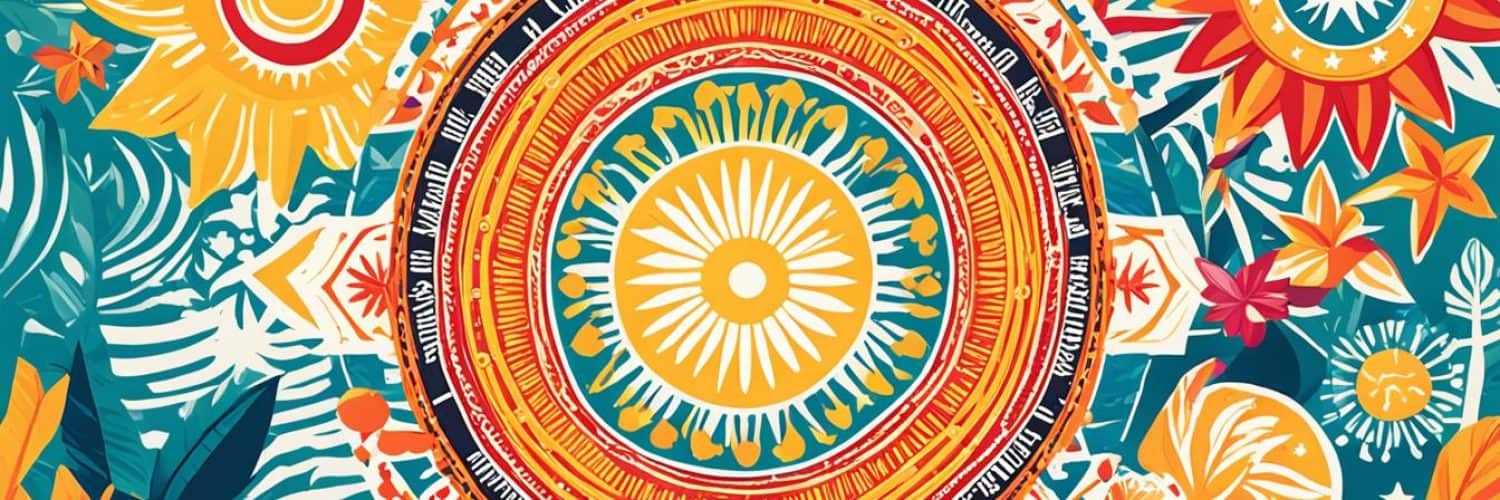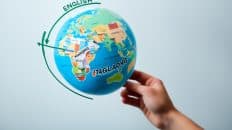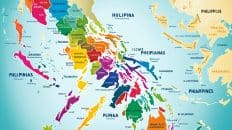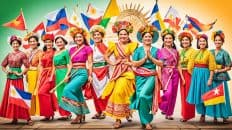Languages around the world are many and fascinating. But what’s the story with Filipino? Is it really a language, or is it something else? Let’s dive into Filipino’s origins, growth, and features. We aim to reveal the real story of its language status. Get ready for a journey that will change what you think and deepen your appreciation for Filipino.
Key Takeaways:
- Filipino is the national language of the Philippines and is interchangeably referred to as Pilipino.
- It is rooted in Tagalog but has been influenced by Spanish, English, and other local languages.
- The Filipino language plays a vital role in preserving cultural identity and fostering a sense of unity among Filipinos.
- There are various dialects of Filipino spoken across different regions of the Philippines.
- Join us on this linguistic journey to gain a deeper appreciation of the beauty and significance of the Filipino language.
Filipino Language Origins and History
The Filipino language started from Tagalog. This is the language of most Filipinos. Tagalog is mainly spoken in the central and southern areas of Luzon. It was the base for the Filipino language’s growth.
Many languages have influenced Filipino through history. This is due to colonization and cultural exchanges. Spanish impact came with the Philippines’ colonization from the 16th to 19th centuries. It brought Spanish words and grammar into Tagalog. We see this in words about religion, government, and daily life.
The English language has shaped Filipino too. It came with American colonization in the early 20th century. English words and phrases became part of Filipino. This is noticeable in technology, business, and pop culture.
The name of the language changed from Pilipino to Filipino in the 1987 Constitution. This was to include words from other Philippine languages. It was a move towards embracing the country’s language diversity.
Today, Filipino is the official language of the Philippines. Many Filipinos speak it as their first or second language. It is used in communication, education, literature, and media. It connects people across the country. It also builds a sense of national identity.
| Language | Influences |
|---|---|
| Tagalog | Native language of the majority of Filipinos |
| Spanish | Introduced during Spanish colonization, influenced vocabulary and grammar |
| English | Introduced during American colonization, impacted various fields and professions |
Characteristics of the Filipino Language
The Filipino language mixes Tagalog, Spanish, and English words. It shows the Philippines’ diverse cultural influences. The language reflects the traditions and heritage of the Filipino people.
Filipino stands out for its fluidity and expressive nature. It lets people share their feelings and thoughts clearly. This makes the language powerful in connecting individuals and expressing emotions.
At the heart of Filipino culture is “kapwa.” It’s about shared identity and connection. This concept is key in the language, promoting empathy and equality. Inclusive language in Filipino stresses unity and inclusiveness.
“The Filipino language mirrors the Philippines’ rich cultural heritage, mixing various languages. Its fluidity and expressive power highlight speakers’ feelings and thoughts. The ‘kapwa’ concept encourages a sense of community and connection.”
Furthermore, the Filipino language includes cultural nuances and respect. It uses honorifics and polite forms to show respect for elders and authority. These elements reflect the value Filipinos place on respect and reverence.
The Influence of Spanish and English
Spanish and English have significantly influenced Filipino. Spanish left a lasting mark from colonial times. Filipino has many words of Spanish origin. This shows the historical bond with Spain and enriches the language.
English affects Filipino, especially today as the Philippines engages globally. English is key for communication and professional growth. It blends well with Filipino, adding to the language’s dynamic nature.
Expressing Filipino Cultural Identity
The Filipino language helps express cultural identity. It captures the richness of Filipino traditions, beliefs, and values. Through it, Filipinos share their heritage and ensure its continuity.
| Characteristics | Description |
|---|---|
| Fluidity | The Filipino language allows for expressive communication with its ability to convey complex emotions and ideas. |
| Cultural Influences | The vocabulary of the Filipino language reflects the cultural diversity and influences on the Philippines. |
| Embracing ‘Kapwa’ | The concept of ‘kapwa’ promotes inclusivity and shared identity within Filipino language and communication. |
| Spanish Influence | The Spanish language has left a lasting mark on Filipino vocabulary, adding richness and depth. |
| English Influence | English words and phrases seamlessly blend with Filipino, reflecting the global nature of the Philippines. |
| Expressing Cultural Identity | The Filipino language is a powerful medium for expressing and preserving Filipino cultural identity. |
The Filipino language’s characteristics show its uniqueness. Its fluidity, cultural diversity, and role in identity make it special. This linguistic tapestry is indeed remarkable.
Influence of Filipino on Other Languages
The Filipino language mixes Tagalog, Spanish, and English. This blend has impacted other languages, especially in the Philippines. Many local dialects have adopted Filipino words and phrases.
This language’s reach goes beyond the Philippines. Thanks to the Filipino diaspora, millions live worldwide. They have spread Filipino to other countries, blending it with local languages and cultures. This creates a link for Filipinos everywhere.
“The Filipino language serves as a cultural link that binds overseas Filipinos to their roots and heritage, allowing them to maintain their identity and connections to the Philippines.”
In places like the United States, Canada, and Australia, you’ll find Filipino in daily talks. It shows how Filipino immigrants and their kids add to the local culture. Their words blend in, showing how adaptable and wide-reaching the Filipino language is.
But Filipino’s impact isn’t just in words. It changes how people talk, from sentence structure to grammar. In Filipino communities abroad, this mix helps create a shared identity and cultural exchange.
Filipino also affects literature, music, and media. Writers and artists use it to express Filipino culture. Through their work, the Filipino language’s influence grows even beyond speaking.
The Influence of Filipino on Other Languages: A Visual Representation
| Language | Examples of Filipino Influence |
|---|---|
| Cebuano | Kumusta ka? (How are you?) |
| Ilocano | No adda. (There is none.) |
| Chavacano | Buenas dias. (Good morning.) |
| Waray | Maupay nga adlaw. (Good day.) |
The table shows how Filipino has influenced Philippines’ dialects. These dialects have picked up Filipino phrases, bringing them closer together.
The adaptability and cultural importance of the Filipino language are clear. It showcases the rich mix of cultures and languages in the Philippines and its people.
Dialects of the Filipino Language
The Filipino language is rich with different dialects across the Philippines. These dialects make the Filipino language unique. They show the culture and history of the Filipino people.
Tagalog is the main dialect and the base of the national language. Many people speak Tagalog, and it’s used in government, media, and schools. Most of the Filipino vocabulary and rules come from Tagalog.
There are other important dialects in the Filipino language. Let’s look at some of them:
- Bisaya (Cebuano) is widely spoken in the Visayas and Mindanao. It has its own words, rules, and sounds.
- Ilocano is mainly used in northern Luzon. It is known for its sweet sound and special grammar. It’s one of the Philippines’ oldest languages.
- Hiligaynon (Ilonggo) is popular in Western Visayas. It’s used a lot in Iloilo and Negros Occidental. This dialect is famous for its poetry and colorful language.
- Kapampangan comes from Pampanga. It has complex rules and many Spanish words. It’s one of the most unique dialects in the Philippines.

Every dialect in the Philippines has its own features, words, and sounds. These differences make the Filipino language interesting. It’s amazing to see how these dialects add to the Filipino language’s charm.
The Script of the Filipino Language
The Filipino language uses the Latin script, the same one English uses. This makes it easy for those who know English to understand. Filipino, though, doesn’t have its own unique script.
However, the Philippines is rich in culture, including various indigenous scripts like baybayin. Baybayin is an old script our ancestors used. They did so long before the Spanish arrived.
Today, there’s a push to bring baybayin back. This effort aims to keep our cultural heritage alive. It celebrates the Philippines’ language diversity. Baybayin is not just writing; it’s a piece of history and culture.
“The use of baybayin not only connects us to our ancestral roots but also serves as a reminder of the richness and uniqueness of our Filipino identity.” – Dr. Eduardo Alba, Filipino Historian
The primary writing system for Filipino is still the Latin script. But, appreciating baybayin helps us understand our linguistic history. It lets us honor our traditions.
Number of Filipino Language Speakers
The Filipino language is widely spoken by many in the Philippines and other countries. There are about 45 million native speakers in the Philippines alone. This makes it one of the primary languages there.
\
Millions more speak Filipino globally, especially in places with big Filipino communities. Filipinos moving to the United States, Canada, Australia, and the UK take their language with them. This keeps their language strong even far from home.
Filipino speakers are everywhere, showing how large and wide-reaching the Filipino community is. The language is key for communication and keeping culture alive for Filipinos abroad.
The Filipino Language in Numbers
| Country | Total Number of Filipino Speakers |
|---|---|
| Philippines | 45 million (native speakers) |
| United States | 3.9 million |
| Canada | 710,000 |
| Australia | 260,000 |
| United Kingdom | 200,000 |
These figures show how widespread Filipino is beyond the Philippines. They prove its role in keeping cultural ties, traditions, and identity among Filipinos worldwide.
Importance of the Filipino Language
The Filipino language is very important for keeping the culture of Filipino people alive. It is a strong way for people to talk, read, and learn all across the Philippines. This language brings people together, making them feel proud of their shared history.
Filipino is the official language of the Philippines. It helps different ethnic groups talk to each other. This brings people closer, making it easier for them to share ideas and strengthen their community.
The language is also key in arts and literature. Writers and artists use it to show the beauty of Philippine culture, history, and identity. It helps them share what it means to be Filipino, capturing the heart of the nation.
Additionally, Filipino is crucial for sharing news and information. It is used in newspapers, TV, radio, and online, helping people stay connected to the world. This keeps Filipinos informed about what’s happening around them.
Empowering Education and Preserving Heritage
In education, Filipino plays a central role. It’s the main language used in schools, which helps students learn better. This ensures all Filipinos can access education and opportunities, no matter their language background.
Using Filipino in education also protects the Philippines’ culture. It teaches students about their heritage, making them proud of their roots. This way, the country honors its diverse cultures and the importance of its language.
The Filipino language is not just a communication tool; it is a gateway to understanding the soul and spirit of the Filipino people.
In conclusion, the Filipino language is vital for the Filipino people. It helps preserve culture, improve communication, support education, and unite the nation. By valuing and promoting it, the Filipino language enriches lives and showcases the Philippines’ rich cultural heritage.
Challenges and Issues Surrounding the Filipino Language
The Filipino language holds great importance yet faces many challenges today. Its place is challenged by the dominance of English in schools and offices. The influence of other local languages also affects its status.
English is seen as a key to global success, leading to a focus on mastering it. This focus sometimes lessens the attention on Filipino. There’s a risk it may become less used in important areas of life.
“English has gained prominence in the Philippines, and while it is important to be globally competitive, we must not forget the importance of preserving our own language and cultural identity.”
The Philippines has a rich variety of languages. This shows the country’s complex history. Yet, this diversity also makes promoting Filipino as the national language challenging.
There are efforts to keep the Filipino language relevant and alive. Organizations and schools are encouraging its use. The government is also taking steps to support the Filipino language.
Integrating Filipino language teaching with its culture in schools is one approach. This lets students master both English and Filipino. It helps foster pride and identity.
The media and entertainment field is also vital in promoting Filipino. Shows, movies, and songs in Filipino boost awareness and appreciation among Filipinos.
“By embracing and cherishing our language, we can forge a stronger sense of unity and pride in our Filipino heritage.”
But, the challenges with the Filipino language can be overcome. With collective effort and commitment, Filipinos can maintain their language’s vibrancy. It’s crucial for their cultural identity.

Achieving Relevance and Vitality
To tackle the Filipino language’s challenges, we must keep it relevant and vibrant. Being relevant means staying updated with changes in language use. It’s also about promoting the language actively.
Increasing Filipino’s use in business, government, and tech helps. Creating new words for these areas can support its growth. Vitality comes from instilling love for Filipino early on. Schools and everyday talks should highlight Filipino.
To preserve Filipino, everyone must play their part. This will ensure its growth and preserve the nation’s heritage for the future.
Filipino Language and Cultural Identity
The Filipino language is a key part of Filipino cultural identity. It combines history, traditions, values, and the Filipino worldview. It’s not just a way to talk; it unites Filipinos with a shared heritage.
Filipino captures the experiences of many generations. It shows the Filipino community’s struggles, wins, and dreams. In its words, Filipino holds history, sharing stories that define the culture. When Filipinos speak or write in it, they feel connected to their past.
“Ang wika natin ay tulay ng ating kultura. Kapag nawala ang wika, nawawala ang kultura.”
These words, believed to be said by Jose Rizal, highlight the Filipino language’s role in preserving culture. They show that language and culture are linked. By using Filipino daily, Filipinos keep their culture alive and well.
Fostering a Strong Cultural Identity
Language is more than just for talking; it expresses culture. Filipino helps share unique Filipino views, values, and lifestyles. It allows deep conversations about traditions and beliefs, connecting people and communities.
Filipino also brings Filipinos together, beyond different regions. It lets them share stories and traditions. Despite diverse dialects and practices, Filipino is a common language that binds Filipinos, highlighting their shared identity.
Preserving Heritage for Future Generations
It’s important to keep the Filipino language for future generations. Using Filipino, the past’s stories stay alive. This ensures that wisdom, knowledge, and traditions are remembered. It helps young Filipinos understand their roots and be proud of their culture.
By valuing Filipino, Filipinos honor their ancestors and add to their cultural legacy. They protect their unique traditions, language, and values for future generations to cherish.
As Filipinos worldwide celebrate the Filipino language, they build a stronger cultural identity. Filipino reminds them of their diversity and unity. By keeping the Filipino language and culture strong, Filipinos ensure a bright future for their heritage, connecting them to their roots across borders.
Filipino Language in a Global Context
The Filipino language is going global as Filipinos move around the world. It helps keep culture intact, maintains traditions, and creates a feeling of home abroad. Filipino also affects other languages, showing its global influence.
This language connects Filipinos overseas with their origins. It’s a way for them to keep in touch and share their cultural legacy. Through talk, music, or books, it unites Filipinos worldwide.
“The Filipino language is not just a tool for communication; it is a vessel that carries our culture, values, and stories. It allows us to express ourselves and connect with our fellow Filipinos wherever they may be in the world.”
The Filipino language’s influence reaches beyond just Filipinos living elsewhere. It blends Tagalog, Spanish, English, and other languages. This mix has changed other languages both within and outside the Philippines.
“Filipino’s global reach illustrates its significance as a dynamic and versatile language that adapts and contributes to the ever-evolving linguistic landscape.”
Many people now see the Filipino language’s cultural value. Groups are working together to promote it through education and celebration. These efforts help keep Filipino culture alive and vibrant globally.
Understanding the Filipino language’s history and culture matters. Getting to know its unique expressions offers a closer look at Filipino identity. This deepens our appreciation of its beauty and impact.
Filipino Language in a Global Context |
|---|
Appreciating the Beauty of the Filipino Language
The Filipino language is a beautiful mix of words and expressions. It captures the rich cultural heritage of the Philippines. It shows the Filipino people’s essence, their history, and lifestyle.
The language’s melody and poetry touch the heart. They make it a unique and precious part of language.
Every Filipino word has its own story. It brings the wisdom and experiences of many generations. Words like “kagandahan” (beauty) and “pagmamahal” (love) show deep human emotions in a special Filipino way.
The Filipino language’s lyrical quality shines when spoken. Its rhythms and tones create a meaningful symphony. This language paints vivid pictures, pulling one into the story.
Learning about the Filipino language helps us understand their culture more deeply. It shows the values and beliefs that shape the Filipino identity. Filipino sayings, proverbs, and literary works show the creativity of the Filipino people.
Embracing this language means connecting with Filipino culture. By learning and speaking it, we enter a world full of stories, songs, and age-old traditions.
Sample Table: Beautiful Words in the Filipino Language
| Word | Meaning |
|---|---|
| Bahagya | Gently, softly |
| Sining | Art |
| Pag-ibig | Love |
| Tadhana | Fate |
| Suyuan | Flirtation, courtship |
The Filipino language beautifully reflects the Filipino spirit. Its rich words, expressive nature, and poetic style draw people in. Appreciating this language lets us honor the culture and connect with the Filipino community.
Embracing the Filipino Language
Understanding the Filipino language can deepen your bond with Filipino culture and its people. It goes beyond words and grammar. Using it daily makes the experience richer.
When you speak Filipino, you create stronger bonds with others. Conversations become more special. It feels more real for everyone involved. This builds a bridge between different cultures.
Benefits of Embracing the Filipino Language
Learning Filipino connects you to the culture. It helps you understand Filipino traditions and values better. You get to appreciate the rich Filipino culture.
Speaking Filipino shows respect and interest in Filipino life. This creates trust and friendship. These strong connections are important.
Speaking Filipino helps keep the language alive. You help preserve a precious part of Filipino heritage. It’s a gift to future generations, keeping the language relevant.
“Embracing the Filipino language is embracing a vibrant and resilient culture.” – Filipino proverb
Knowing Filipino can help your career. It opens many doors in the business world. You’ll connect better with Filipino colleagues and customers. This makes you stand out in a crowded job market.
Ways to Embrace the Filipino Language
Join Filipino classes or look for tutorials online. This will improve your language skills. You’ll learn the basics and more about the culture.
Talking with native speakers is very helpful. Join conversations and learn from them. They can offer real insight into the language.
Explore Filipino culture through its music, movies, and literature. These can deepen your understanding of the language. They show the language’s beauty in real-life contexts.
Visiting the Philippines is a great way to learn. Talk with locals and explore. This experience will speed up your learning process.
Learning Filipino takes time and effort. Keep an open mind and stay dedicated. As you learn more, you’ll appreciate Filipino culture even more.
Dive into the Filipino language for a rewarding experience. It will enrich your life personally and professionally. You’ll build lasting relationships and help preserve a beautiful language.
Conclusion
The Filipino language is very important to the culture and identity of the Philippines. Over time, it has taken in elements from many languages. This has made it a rich mix of words and meanings. It is a key way Filipinos talk, share their culture, and connect with each other.
We need to value and keep the Filipino language alive. Using it every day helps us stay close to our Filipino roots. It also helps us build stronger relationships with others who share our culture. Supporting our language means we help keep the Filipino identity strong and recognized.
Filipino language is not just words. It carries the heart of Filipino tradition, history, and values. When we learn about its beauty, we come to love Filipino culture even more. Let’s all keep using and valuing the Filipino language. It’s a big part of what makes us uniquely Filipino.







Add comment